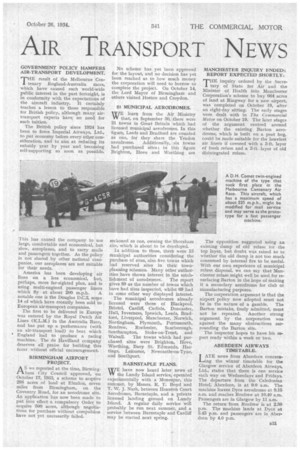AIR TRANSPORT NEWS
Page 45

If you've noticed an error in this article please click here to report it so we can fix it.
GOVERNMENT POLICY HAMPERS AIR-TRANSPORT DEVELOPMENT.
"THE result of the Melbourne Cen tenary England-Australia races, which have caused such world-wide public interest in the past fortnight, is in conformity with the expectations of the aircraft industry. It certainly teaches a lesson to those responsible for British policy, although many airtransport experts have, no need for such tuition.
The British policy since 1924 has been to force Imperial Airways, Ltd., to put economy before every other consideration, and to aim at reducing its subsidy year by year and becoming self-supporting so soon as possible.
This has caused the company to use large, comfortable and economical, but slow, aeroplanes, and to carry mails and passengers together. As the policy is not shared by other national companies, our aeroplanes are not suitable for their needs.
America has been developing air lines on a less economical, but, perhaps, more far-sighted plan, and is using multi-engined passenger liners which fly at about 200 m.p.h. A notable one is the Douglas D.C2, some 14 of which have recently been sold to European air-transport companies.
The first to be delivered in Europe was entered by the Royal Dutch Air Lines (K.L.M.) in the Australia Race, and has put up a performance (with an air-transport load) to beat which England had to produce a racing machine. The de Havilland ccmpany deserves all praise for building this racer without official encouragement.
BIRMINGHAM AIRPORT PROJECT.
As we reported at the time, Birmingham City Council approved, on October 17, 1933, a scheme to acquire 298 acres of land at Elmdon, seven miles from Birmingham, on the Coventry Road, for an aerodrome site. An application has now been made to put into effect a compulsory Order to acquire 500 acres, although negotiations for purchase without compulsion have not yet necessarily failed.
No scheme has yet been approved for the layout, and no decision has yet been reached as to how much money the corporation will need to borrow to complete the project. On October 14, the Lord Mayor of Birmingham and others visited Heston and Croydon.
21 MUNICIPAL AERODROMES.
WE learn from the Air Ministry that, on September 20, there were 21 towns in Great Britain which had licensed municipal aerodromes. In this figure, Leeds and Bradford are counted as one, for they share the Yeadon aerodrome. Additionally, .six towns had purchased sites ; in this figure Brighton, Hove and Worthing are
reckoned as one, owning the Shoreham site, which is about to be developed.
In addition to these, there were 13 municipal authorities considering the purchase of sites, also five towns which had reserved sites in their townplanning schemes. Many other authorities have shown interest in the establishment of aerodromes. The report gives 89 as the number of towns which have had sites inspected, whilst 69 had in some other way displayed interest.
The municipal aerodromes already licensed were those of Blackpool, Bristol, Cardiff, Carlisle, Doncaster, Hull, Inverness, Ipswich, Leeds, Bradford, Liverpool, Manchester, Norwich, Nottingham, Plymouth, Portsmouth, Renfrew, Rochester, Scarborough, Southampton, Stoke-on-Trent, and Walsall. The towns which had purchased sites were Brighton, Hove, Worthing, Bury St. Edmunds, Hastings, Leicester, Newcastle-on-Tyne, and Southport.
BARNSTAPLE PLANS.
VUE have now heard later news of VV the Lundy Island service, operated experimentally with a Monospar, this summer, by Messrs. R. T. Boyd and T. W. J. Nash, between Heanton Court Aerodrome, Barnstaple, and a private licensed landing ground on Lundy Island. A regular daily service will probably be run next summer, and a service between Barnstaple and Cardiff may be started next spring. MANCHESTER INQUIRY ENDED: REPORT EXPECTED SHORTLY; rrIE inquiry ordered by the Secre tary of State for Air and the Minister of Health into Manchester Corporation's scheme to buy 664 acres of land at Ringway for a new airport, was completed on October 19, after an eight-day sitting. The early stages were dealt with in The Commercial Motor on October 19. The later stages of the argument centred around whether the existing Barton acredroroe, which is built on a peat bog, could be made suitable for the heaviest air liners if covered with a 3-ft. layer of fresh refuse and a 2-ft. layer of old disintegrated refuse.
_ The opposition suggested using an existing dump of old refuse for the top layer, but doubt was raised as to whether the old dump is not too much consumed by internal fire to be useful. With our own experience of municipal refuse disposal, we can say that Manchester refuse might well be used for resurfacing Barton in the hope of making it a secondary aerodrome for club or manufacturing purposes.
The corporation argument is that the airport policy now adopted must not be in the nature of a. gamble. The Barton mistake, freely admitted, must not be repeated. Another strong argument by the corporation was against the many obstructions surrounding the Barton site. '
The inspector hopes to have his report ready within a week or two.
ABERDEEN AIRWAYS TIMETABLE.
LATE news from Aberdeen concerning the winter timetable for the Glasgow service of Aberdeen Airways, Ltd., states that there is one service each way on Wednesdays and Fridays. The departure from the Caledonian Hotel, Aberdeen, is at 9.0 a.m. The machine leaves Dyce aerodrome at 9.15 a.m. and reaches Renfrew at 10.40 a.m. Passengers are in Glasgow by 11 a.m.
The return from Renfrew is at 2.30 p.m. The machine lands at Dyce at 3.45 p.m. and passengers are in Aberdeen by 4.0 p.m.




























































































